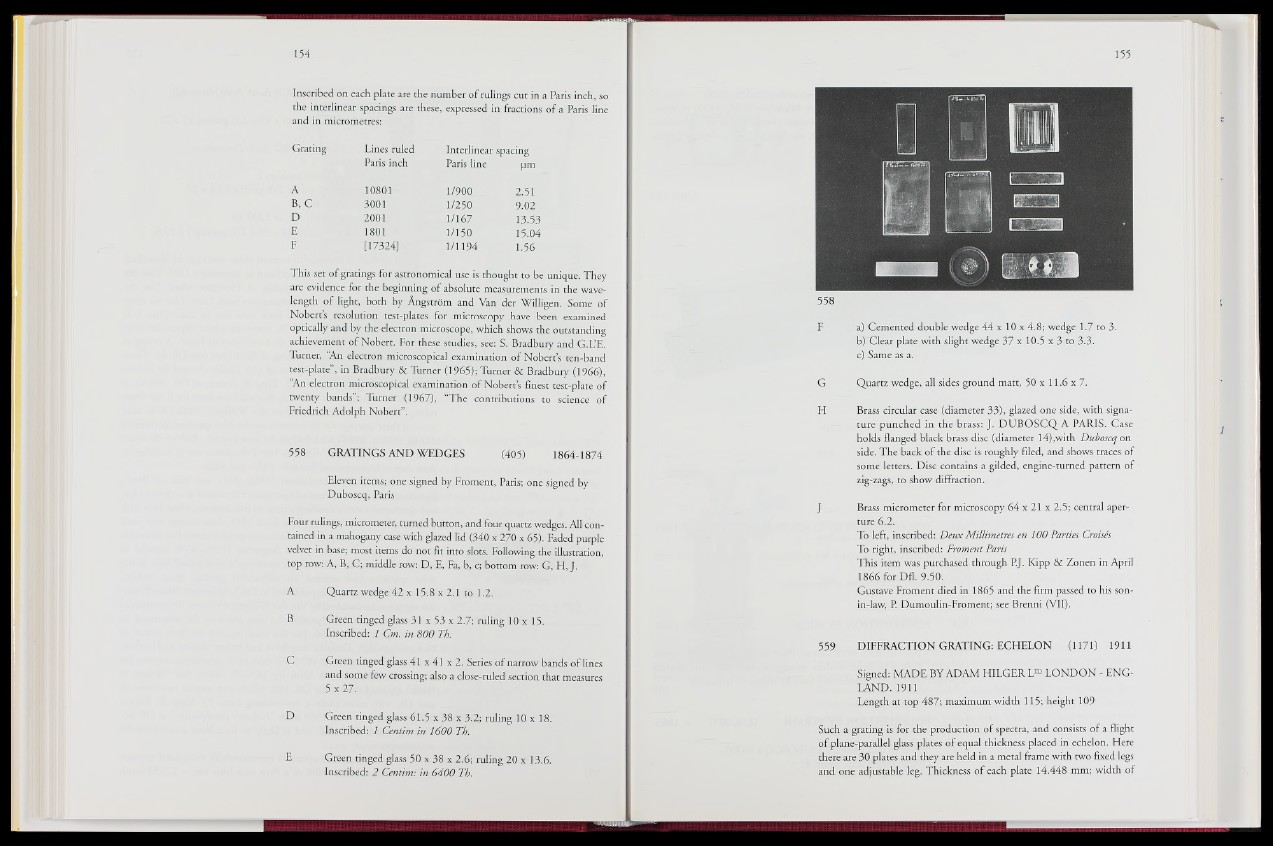
Inscribed on each plate are the number of rulings cut in a Paris inch, so
the interlinear spacings are these, expressed in fractions of a Paris line
and in micrometres:
Grating Lines ruled Interlinear spacing
Paris inch Paris line pm
A 10801 1/900 2.51
B, C 3001 1/250 9.02
D 2001 1/167 13.53
E 1801 1/150 15.04
F [1 7324® 1/1194 1.56
This set of gratings for astronomical use is thought to be unique. They
are evidence for the beginning of absolute measurements in the wavelength
of light, both by Angstrom and Van der Willigen. Some of
Nobert’s resolution test-plates for microscopy have been examined
optically and by the electron microscope, which shows the outstanding
achievement of Nobert. For these studies, see: S. Bradbury and G.L’E.
Turner, “An electron microscopical examination of Nobert s ten-band
test-plate”, in Bradbury & Turner (1965); Turner & Bradbury (1966),
“An electron microscopicid examination of Nobert s finest test-plate of
twenty bands ; Turner (1967), “The contributions to science of
Friedrich Adolph Nobert”.
558 GRATINGS AND WEDGES (405) 1864-1874
Eleven items; one signed by Froment, Paris; one signed by
Duboscq, Paris
Four rulings, micrometer, turned button, and four quartz wedges. All contained
in a mahogany case with glazed lid (340 x 270 x 65). Faded purple
velvet in base; most items do not fit intpjslots. Following the illustration,
top row: A, B, C; middle row: D, E, Fa, bf bottom row: G, H, J.
A Quartz wedge 42 x 15.8 x 2.1 to 1.2.
B 'Green tinged glass 31 x 53 x 2.7; ruling 10 x 15.
Inscribed: 1 Cm. in 800 Th.
Green tinged glass 41 x 41 x 2 . Series of narrow bands of lines
and some few crossing; also a close-ruled section that measures
5 x 2 7 .
D Green tinged glass 61.5 x 38 x 3.2; ruling 10 x 18.
Inscribed: 1 Centim in 1600 Th.
E Green tinged glass 50 x 38 x 2.6; ruling 20 x 13.6.
Inscribed: 2 Centim: in 6400 Th.
558
F "a) Cemented double wedge 4f$x 10 x 4.8; wedge 1.7 to 3.
b) Clear plate with slight wedge 37 x 10.5 x 3 to 3.3.
c) Same as a.
G Quartz wedge, all sides ground matt, 50 x 11.6 x
H Brass circular case (diameter 33), glazed one side, with signature
punched in the brass: ™KDUBOSCQ A PARIS. Case
holds flanged black brass disc (diameter 14),with Duboscq on
side. The back of the disc is roughly filed, and shows traces of
some letters. Disc contains a gilded, engine-turned pattern of
zig-zags, to show diffraction.
J Brass micrometer for microscopy 64 x 21 x 2.5; central aperture
6.2.
To left, inscribed: Deux Millimetres en 100 Parties Croisés
- To right, inscribed: Froment Paris
This item was purchased through P.J. Kipp & Zonen in April
1866 for Dfl. 9.50.
Gustave Froment died in 1865 and the firm passed to his son-
in-law, P. Dumoulin-Froment; see Brctmi (VII).
559 DIFFRACTION GRATING: ECHELON ¡|l,171.) 1911
Signed: MADE BY ADAM HILGER L™ LO N D O l|| ENGLAND.
19-11
Length at top 487; maximum width 115; height 109
Such a grating is for the production of spectra, and consists of a flight
of plane-parallel glass plates of equal thickness placed in echelon. Here
there are 30 plates and they are held in a metal frame with two fixed legs
and one adjustable leg. Thickness of each plate 14.448 mm; width of